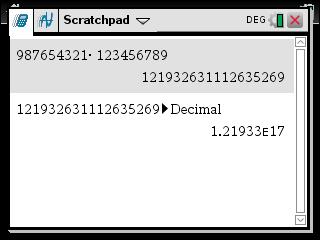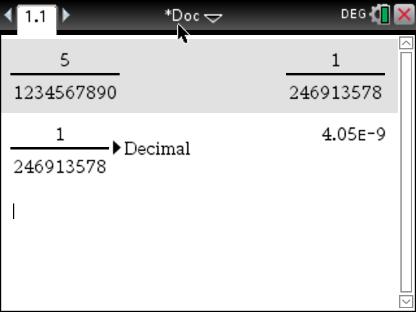Standard Form - Part 1
(How to write a number in standard form)
The idea behind standard form is to write both very large and very small numbers in a convenient form. Here are a couple of examples of numbers written in standard form:
- the distance from the Earth to the Sun is: \(149\ 600 \ 000 \ 000 \) m. In standard form this is written \(1.49 \times 10^{11}\) m.
- The size of a Molecule of Oxygen is: \(0.000000000152\) m. In standard form this is written \(1.52 \times 10^{-10}\) m.
Tutorial 1: Writing Numbers in Standard Form
In this tutorial we learn how to write numbers in standard form. We do so by writing the three numbers:
- \(273\ 000\ 000\)
- \(0.0000273\)
- \(4\ 050\)
Standard Form
When we write a number in standard form, we must write it in yje following way: \[a \times 10^k\] where the following two conditions must be met:
- \(1 \leq a < 10\), the number \(a\) must be greater than, or equal to, \(1\) and must be less than \(10\).
- \(k\in \mathbb{Z}\), in other words the power on \(10\) must be an integer: \(\mathbb{Z} = \left \{ \dots , -3, \ -2, \ -1, \ 0, \ 1, \ 2, \ 3, \ \dots \right \}\)
Exercise 1
Write each of the following numbers in standard form:
- \(3,240,000 \)
- \(0.0000123\)
- \(137,000\)
- \(0.0074\)
- \(607,000,000,000\)
- \(0.000000103\)
- \(9 \)
- \(0.67\)
- \(43,000\)
- \(0.00089\)
Solution Without Working
We find the following results:
- \(3,240,000 = 3.24 \times 10^6\)
- \(0.0000123 = 1.23 \times 10^{-5}\)
- \(137,000 = 1.37 \times 10^5\)
- \(0.0074 = 7.4 \times 10^{-3}\)
- \(607,000,000,000 = 6.07 \times 1O^{11}\)
- \(0.000000103 = 1.03 \times 10^{-7}\)
- \(9 = 9\times 10^0 \)
- \(0.67 = 6.7\times 10^{-1}\)
- \(43,000 = 4.3\times 10^4\)
- \(0.00089 = 8.9 \times 10^{-4}\)
Rounding & Standard Form
When writing numbers in standard form, we usually round numbers to two or three significant figures. For instance, consider the number: \[2 \ 347 \ 128\] Without any rounding, writing this in standard form, leads to: \[2.347128\times 10^6\] This notation isn't practical. Instead, when writing numbers in standard form, we usually round to 2 or 3 significant figures, so that \(2.347128\times 10^6\) becomes:
- \(2.3\times 10^6\) to two significant figures (2 sf)
- \(2.35\times 10^6\) to three significant figures (3 sf)
Exercise 2
Writing all of your answers to three significant figures, write each of the following in standard form:
- \(278,120,001\)
- \(0.0004352617\)
- \(31,906,321,003\)
- \(0.000000789654\)
- \(301,888 \)
- \(0.010345\)
- \(978,909,456,001,745\)
- \(0.0050216\)
- \(8,927\)
- \(0.435269\)
Solution Without Working
We find the following results:
- \(278,120,001 = 2.78 \times 10^6\)
- \(0.0004352617 = 4.35 \times 10^{-4}\)
- \(31,906,321,003 = 3.19\times 10^9\)
- \(0.000000789654 = 7.90 \times 10^{-7}\)
- \(301,888 =3.02 \times 10^5\)
- \(0.010345 = 1.03\times 10^{-2}\)
- \(978,909,456,001,745 = 9.79 \times 10^{14}\)
- \(0.0050216 = 5.02\times 10^{-3}\)
- \(8,927 = 8.93\times 10^3 \)
- \(0.435269 = 4.35\times 10^{-1}\)
Standard Form & Calculators
Although some calculators can present results in standard form, many use a slightly different notation to the one we have see here.
Calculators replace the number \(10\) by the letter \(E\)
Examples
Here are some examples of what a calculator can display and the number, in standard form, they are referring to.
Example 1
With your calculator, try calculating: \[987,654,321 \times 123,456,789\] You're likely to find: \[1.21933\text{E}17\] This means: \[1.21933\times 10^{17}\]

Notice that we had to convert the number in decimal form, via:
Example 2
With your calculator, try calculating: \[5 \div 1234567890\] You're likely to see a result looking like: \[4.05\text{E}-9\] This means: \[4.05\times 10^{-9}\]

Notice that we had to convert the number in decimal form, via:
Scan this QR-Code with your phone/tablet and view this page on your preferred device.
 Subscribe to Our Channel
Subscribe to Our Channel
Subscribe Now and view all of our playlists & tutorials.